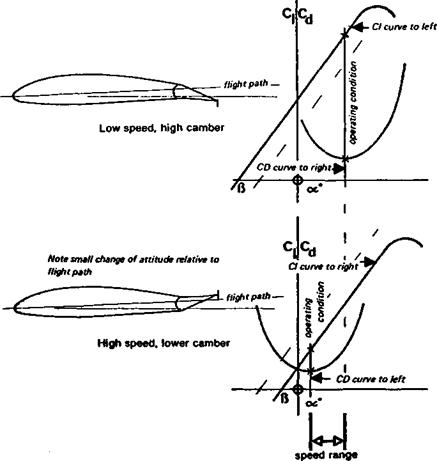MO DESIGN OF CAMBER FLAPS
Піе design of variable camber wings is not easy. The air must not be forced to flow round sharp comers or meet severe adverse pressure gradients, since the boundary layer can easily separate and cause very high drag. Flap hinge lines must be carefully sealed to prevent leakages from high to low pressure sides of the wing, or from inside the wing to the jutside. Ideally, the whole aerofoil should be designed for use with flaps. The flap should
|
Fig. 7.9 Plain flaps used to widen the speed range of a sailplane
|
extend across the whole span, not terminating at the ends of the ailerons. The ailerons should droop or rise together with the flaps. This is particularly important at low speeds, since the sharp change in angle of attack caused where the flap ends amounts to giving the wing a very pronounced and abrupt washout, with bad effects on the carefully designed elliptic lift distribution, and hence high induced drag. The flaps may also be used by themselves as landing aids. Some successful multi task sailplanes use ailerons and flaps opposed for landing, both the ailerons being deflected up as the flaps go down. This creates both high profile drag and vortex drag where the flap and aileron meet at very different angles. Advances in electronic coupling of controls has greatly eased the problem of engineering involved in such a system. It is commonly found that, with this arrangement, some aileron control is lost at low speed.
A true variable camber wing, with a flexible skin on one or both surfaces and internal levers to increase or decrease curvature, is aerodynamically superior to a wing with flaps. Some full-sized sailplanes have adopted such devices (e. g. the HKS series, and the Polish Jantar). With modem plastic materials it is quite feasible for a model to have a flexible surface on one side, so that the simple flap joint is fully sealed and smoothly curved, rather than sharply kinked (Fig. 7.11).












